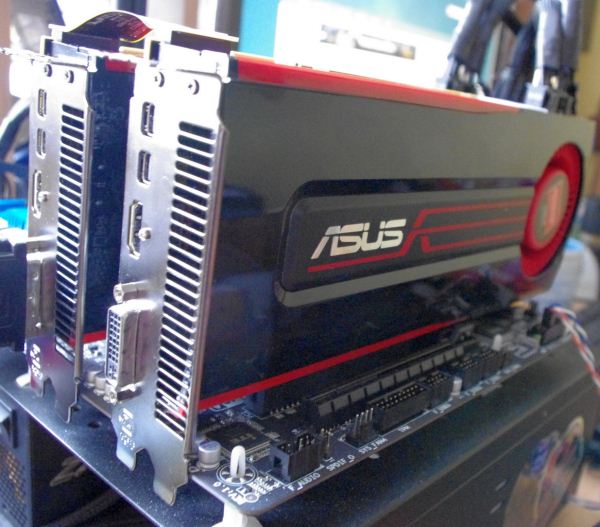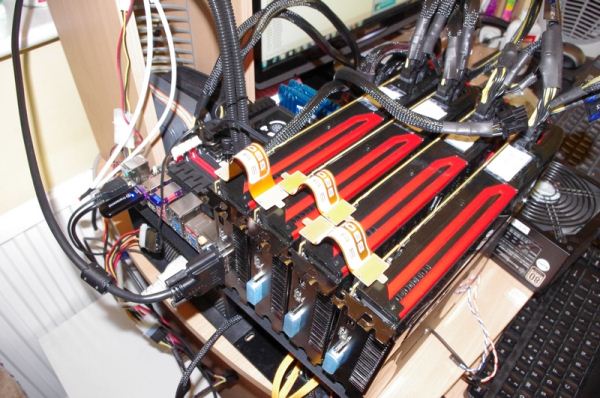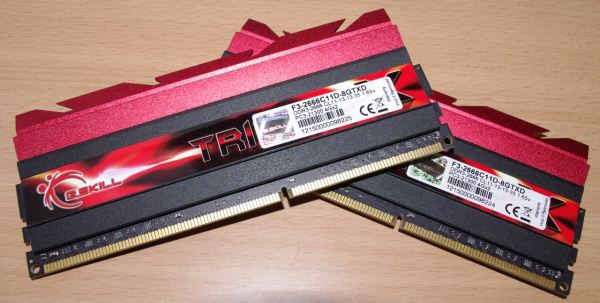Intel Z77 Motherboard Review with Ivy Bridge - ASRock, ASUS, Gigabyte, and MSI
by Ian Cutress on May 7, 2012 7:40 PM EST- Posted in
- Motherboards
- MSI
- Gigabyte
- ASRock
- Asus
- Ivy Bridge
- Z77
Updates to our Testing Methodology
In light of various requests and as a naturally evolving process, some of our motherboard tests have changed. This has the unfortunate consequence of making many of our previous results incomparable, but if they were never updated, we would still be on Catalyst 6.3 or something similar! Also with experience allows us to pick tests that are able to run and give a nice score without having to sit with a stopwatch for twenty minutes each time.
For our CPU tests, we introduce Xilisoft Video Converter, a tool used to convert one type of video to another. What I like about XVC is that it works using all threads available as much as it can, and if you have a GPU that is compatible, it will use it to help speed up conversion. We also add in x264 HD Benchmark, a standard video encoding benchmark that a few other review websites use.
For the system benchmarks, we utilize two new features for USB testing. In terms of hardware, we use a SATA 6 Gbps to USB 3.0 device connected up to an OCZ Vertex3 240 GB drive in order to really stress both USB 2.0 and USB 3.0. For this test, we are also using software called DiskBench - a utility that records accurate times to copy from one drive through the USB to another.
Our GPU test suite also gets a bump. Previously all benchmarks were run at 1920x1080, a reasonable gaming screen size. Today we move all our benchmarks up to 2560x1440 using a 27" Yamakasi Catleap Q270 LED, a common Korean gaming monitor. In terms of actual GPUs, we are retiring our now two generations old HD 5850s, and with many thanks to ASUS, now using a set of HD 7970s for up to four-way CrossFireX (should the motherboard allow it). For NVIDIA, we still use a pair of ECS GTX 580s for SLI testing. The games are also changing with AVP becoming a relatively trivial (120 FPS+) benchmark at 1920x1080, so we are replacing it with Civilization 5 at 2560x1440.
Test Setup
| Processor |
Intel Core i7-3770K ES 4 Cores, 8 Threads, 3.5 GHz (3.9 GHz Turbo) |
| Motherboards |
ASRock Z77 Extreme4 ASUS P8Z77-V Pro Gigabyte GA-Z77X-UD3H MSI Z77A-GD65 |
| Cooling | Intel All-in-One Liquid Cooler |
| Power Supply | OCZ 1250W Gold ZX Series |
| Memory |
GSkill RipjawsZ 4x4 GB DDR3-2400 10-12-12 Kit GSkill TridentX 2x4 GB DDR3-2666 11-13-13 Kit |
| Memory Settings | XMP (1866 9-10-9) |
| Video Cards |
ASUS HD7970 3GB ECS GTX 580 1536MB |
| Video Drivers |
Catalyst 12.3 NVIDIA Drivers 296.10 WHQL |
| Hard Drive | Micron RealSSD C300 256GB |
| Optical Drive | LG GH22NS50 |
| Case | Open Test Bed - CoolerMaster Lab V1.0 |
| Operating System | Windows 7 64-bit |
| SATA Testing | Micron RealSSD C300 256GB |
| USB 2/3 Testing | OCZ Vertex 3 240GB with SATA->USB Adaptor |
Many thanks to...
Many thanks to ASUS as they have kindly allowed us to retire our now two generations old HD 5850s. By providing us with a set of ASUS HD 7970s for up to four-way CrossFireX, we can really test any system that comes our way (coupled with that 2560x1440 monitor).
The ASUS HD7970-3GD5 was ASUS' first 7970 product on the market, using the reference design but being coupled with ASUS GPU Tweak software and support. These cards offer solid performance, and I have easily overclocked them from 925/1375 to 1200/1800 with small bumps in voltage. With any luck, the limiting factor for the next few generations of motherboards will be the motherboard rather than our GPU in the GPU testing, as well as some special X79 boards we are testing soon.
A little preview of some overclocking I have done with these cards for a future review
Many thanks should also go to G.Skill, for sending us one of their new TridentX memory kits designed specifically for the Z77 Platform. The kit they have sent is the F3-2666C11D-8GTXD, or put simply, a dual channel 8 GB kit (two 4 GB modules) designed to run at DDR3-2666 MHz with 11-13-13-35 timings at 1.65 volts.
Having DDR3-2666 memory does seem a little far-fetched, given that Panther Point and the CPUs are only rated up to DDR3-1600. However, with the integrated memory controller on Ivy Bridge, most motherboards should support up to DDR3-2666 to DDR3-2800 by default. In the real world, this means that bulk memory transfers, or memory transfer limited situations, should get a boost. This is in the realm of video processing, or integrated graphics gaming, or multi-monitor gaming (depending on how the game is processed). However, given that motherboard manufacturers are releasing the fact that their motherboards should support these high frequencies, it does not hurt to test them!
In terms of G.Skill’s part in all this – their TridentX range will cover dual channel kits and quad channel kits, from 2x4 GB kits, 2x8 GB kits, 4x4 GB kits and to 4x8 GB kits. The smaller 4 GB module kits will have speeds from 2400 to 2800 MHz, and are assured to be competitively priced, as well as overclockable. In terms of our 2x4 GB 2666 11-13-13 kit, we were able to bump up the ratio to 2800 MHz without any change of voltage or subtimings. With a little voltage push, we were able to go to 2950 MHz with some frequency adjustments. As long as the CPU can take it, it seems that G.Skill have some overclockable kits ready for the taking.














117 Comments
View All Comments
bojaka - Thursday, June 28, 2012 - link
Hi,On Gigabyte's homepage it says:
4 x 1.5V DDR3 DIMM sockets supporting up to 32 GB of system memory
regarding supported/recommended memory for this mainboard...
How come 1.65V memory is used and what are the (possible) consequences?
Should 1.5 or 1.65V memory be used?
Best regards // BoJaKa
Neoprimal - Tuesday, July 31, 2012 - link
Builders with more than a keyboard and mouse may have some issues with the UD3H. I recently got one because of some good reviews I read and the price/value of the board and I was on the cusp of exchanging it for something else because the board was just so unfriendly re: the VIA USB 3 ports.You need to populate the Intel ones before the VIA ones - not an issue. But the second you start populating the VIA ones you stand to get pretty frustrated. Each BIOS revision seems to fix the problem little by little (the saving grace thus far).
The board also doesn't seem to like Sandforce. I am hearing Everest 2 is giving some folks problems as well. After the long term, I had a Solid 3 that kept causing issues. Granted, most folks would say that this is because the Solid 3 is simply a 'crappy SSD', but it did work on other systems so crappy or not there's something to be said about the pairing of it and the UD3H.
The VIA audio didn't play well with my G930 headset. It would literally keep dropping out whenever I reboot and what this in turn did was set the G930 as default...that got annoying fast as I'd have to set the VIA back to default every, single, time. My fix was to unplug the USB key for the G930, a less than elegant response.
Before unscrewing and repackaging the board for return to Newegg since everyone was telling me it was defective, I decided to try one more thing (based on how well things seemed to work when my G19 was on the front USB 2 port); I purchased a USB 2 bracket (4 port) and attached it to the 2 USB headers I had left. I then plugged my 2 hubs (housing my printer, gamepad, flash drives, etc) on the USB 2 ports, put my G19 keyboard on a VIA USB 3 port (as these are the only ports that work 100% pre-boot) and put my 2 USB 3 hard drives on the Intel USB 3 ports where I pretty much leave them. This is the only way I have been able to run the board stable.
It was a lot to go through but things now work. If this were my first board I'd have been in trouble. Initially you don't experience the issues. It's when you move beyond a keyboard and mouse that you start seeing problems.
I wish reviewers did more than just stuck a keyboard and mouse on these boards. I get that the review process can be grueling but most people nowadays have more than a KB and Mouse and a review should put a board through more paces than just overclocking. These manufacturers put so much into 'tweaking' the boards for OCing they are getting lazy with the rest of stuff. It seems a lot of boards experience USB problems, despite the various chips they use.
I don't know if I'll ever use all of the onboard ports, I know that I don't DARE change anything, lest I go back to the reboots and crashes that occurred before I found my fix.
xs7v3n - Tuesday, August 7, 2012 - link
So i see almost everyone here is dealing with the slow post time.Most of the time my post time is around 8 seconds (sometimes its around 4 seconds), while Dr. Debug lcd on mobo is showing a "99" post then it loads up the windows 7 loading screen (but sometimes after the post a blank screen with that "_" [underscore] appearance like when u open cmd which takes like at least 8 seconds also).. I have a Corsair Force GT 240gb and i want to get the most speed out of this system on boot up.
xs7v3n - Tuesday, August 7, 2012 - link
Actually it wasn't 8sec it was more like 24seconds LOL and so sometimes its 8 seconds... Why is that taking that post so long to disappear?Raikku - Wednesday, September 5, 2012 - link
Why I don't have that auto-oc option in my Ext4's bios/oc-tweaker screen?Nanology - Monday, September 17, 2012 - link
Great review, it's cleared up a lot for me.It's been around 5yrs since I have updated my gaming rig.
I would like to be able to run a variety of games at med. settings and also stream games!
Also use a lot of Adobe products, video editing etc, and some 3d level design, but nothing to crazy!
Budget upgrade:
Intel i5-3570k
G.SKILL Ripjaws X Series 8GB DDR3 2133
Can't decide on one of these motherboards...
I currently have a CM Gemini II LGA 775 heat sink, which the ASRock board supports = saves money!
Do all these boards support a LGA 775 heat sink?
I was looking at the ASRock z77 pro4 for around $109, but really like the ASRock ex4
The 555 is nice and I would actually use it.
Can someone please help me sway my decision?!?!??!?!?!?
jonjonjonj - Saturday, November 17, 2012 - link
im seriously thinking about thie asrock extreme4 but the 2 PCI slots bother me. PCI-e came out in 2004. its 2012 time to ditch the PCI slots. if your getting a Z77 board and still use a PCI card its either time to upgrade that card or since you insist on using a 10 year old card stick with your old board.